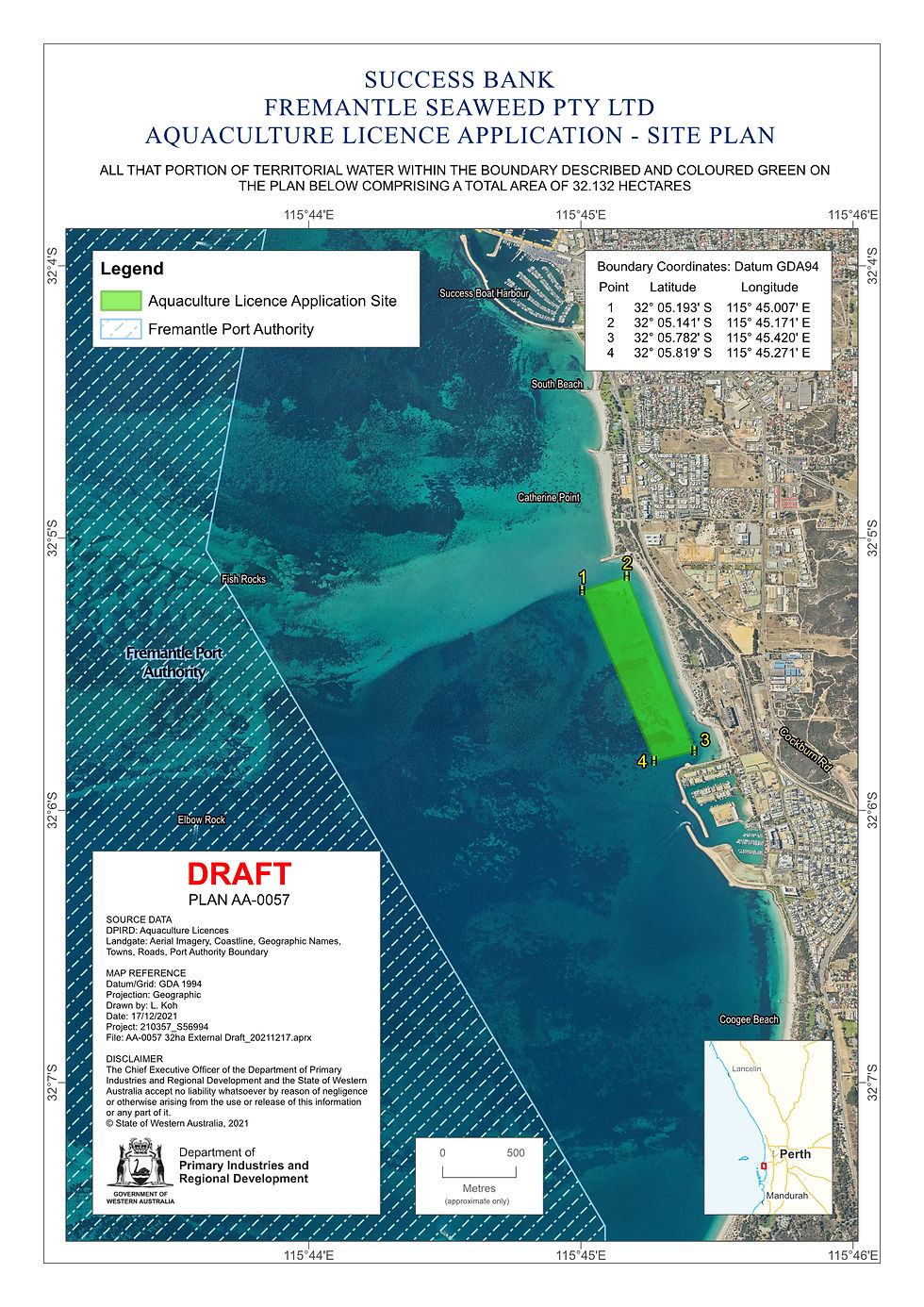Seaweed farming takes off in Fremantle
- Catherine Norwood

- Jan 27, 2023
- 3 min read

After almost three years in development, Fremantle Seaweed has won approval for its marine farm and expects to harvest its first crop of Asparagopsis in May.
Having secured approval for their seaweed farm from the Western Australian Government late in 2022, co-founders of Fremantle seaweed Chris De Cuyper and Mick Holland are excited to finally be putting equipment – and more importantly seaweed – into the water in February.
Theirs is a new marine lease, rather than a variation to an existing aquaculture site. They have 32 hectares approved to grow seaweed at Derbal Nara – Cockburn Sound.
And while they’ve been approved to grow as many as 15 native species, Chris says their initial focus will be on Asparagopsis, the red seaweed generating international interest for its ability to reduce methane emissions from livestock.
This is the species that seems to offer the greatest impact on climate change in the shortest time frame, he says, and addressing climate change has been a key driver in founding the business.
But they have also identified a native red Porphyra lucasii species. Internationally, Porphyra is used to make nori (dried seaweed sheets) and is an important ingredient in Japanese cuisine. Other species on their list have high levels of carrageenan, agar or alginate, all ingredients widely used as gelling and thickening agents in commercial food processing.
Seaweed in the water
To secure its seed stock, Fremantle Seaweed is looking to work with Dr John Sutton at the University of Western Australia where a hatchery is being established.
Chris says they are planning to trial two methods to establish Asparagopsis plants. One uses established seedlings (gametophytes) that are attached to lines. The other is to encourage the Aparagopsis seeds (sporophytes) to settle directly onto a substrate, such as twine. He says while the second technique seems more difficult to achieve, they expect it will result in the ability for seeded substrate to survive in robust ocean conditions.
“But initially we’re just looking to prove that our lease is a good place to grow Asparagopsis,” says Chris. “There is Asparagopsis growing in the wild close to the lease area, so we think it will be.” Both forms of Asparagopis, taxiformis and armata, grow naturally in the Fremantle region, in opposite seasons, which will allow them to produce at least two harvests a year.
“We also have to work out the appropriate planting density for the crop, taking into consideration our permit requirements; for instance, we can’t shadow seagrasses which would prevent them from growing. We’re still very much experimenting at this stage.”
Aquaculture students from South Metro TAFE will help with the initial seeding and setting of lines. The farm uses a backbone design with seeded lines hanging from a main line. Chris says while the TAFE students are principally studying finfish aquaculture, he is hopeful there may be a few converts to seaweed as a result of the collaboration with Fremantle Seaweed.
After putting the crop in the water in February, a harvest is planned for late May, before the water gets colder and the plants begin to die off.
The findings from a two-year research project ‘Developing Asparagopsis cultivation at scale for rapid industry growth’ at the University of Western Australia are expected to help them to refine their farming methods. This project has been led by Dr Statton and is funded by AgriFutures Australia. It is due to report in June 2023.

Hatchery network
Commenting on the availability of seed stock, Chris is supportive of a national seaweed hatchery network that can supply various types of seaweed from Asparagopsis to kelps.
“That would be a great opportunity for collaboration,” he notes. “I like the model of the oyster hatchery in WA, which is owned by the government, but run by a private operator who provides oyster spat that oyster growers buy and grow out.
“A model like that for seaweed would be a great support for smaller businesses like Fremantle Seaweeds. And it would help us to make the most of the ocean resources that Australia has,” he adds.
In addition to the Derbal Nara – Cockburn Sound site, Fremantle Seaweed is looking at other possible marine lease sites along the WA coast, including as far north as Carnarvon.
The business has also received a state-based Blue Gravity grant that supports marine innovation and collaboration. This will fund consultations with the business facilitation firm For Blue to help develop its business model and financial plans, as production gears up.
More information: Fremantle Seaweed
Instagram: @fremantleseaweed








Comments